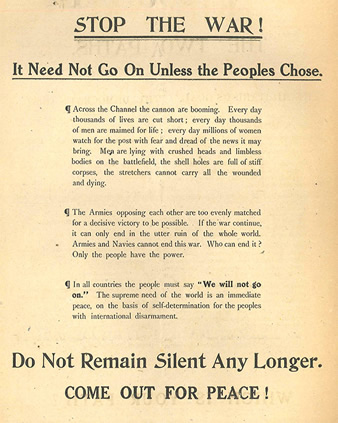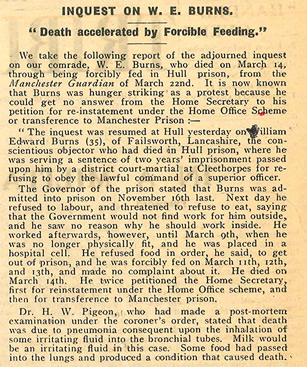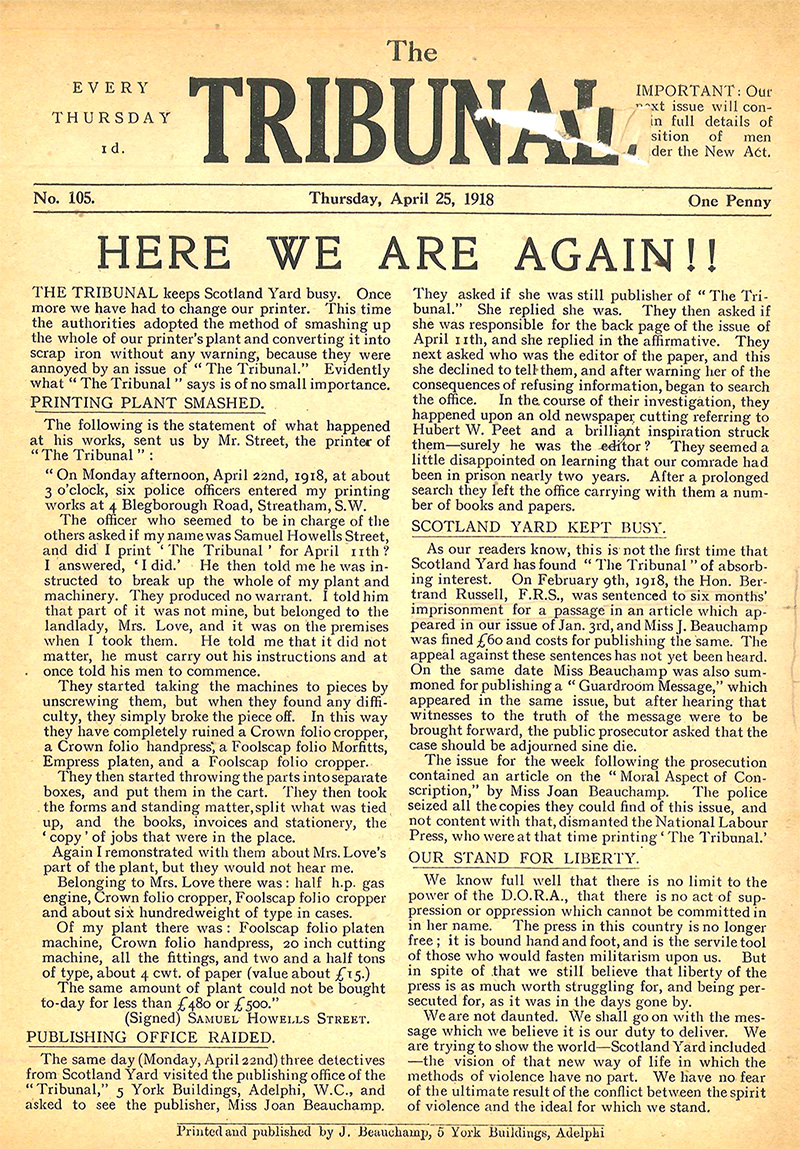
| HOME | TRIBUNAL HOME |
April 1918
The relative calm and caution in the face of state oppression that pervades the March 1918 issues of the Tribunal lasts exactly four days into April. Far from the reprints and almost-conciliatory articles of the month before, April 1918 sees the Tribunal back at it’s most vociferous.
4th April: Death of W.E. Burns and P. L Gillan
One likely candidate for this rapid switch in approach was the sad duty of the Tribunal to report on the deaths of Conscientious Objectors around the country. Though obituaries were by now an almost fortnightly feature of the paper, the deaths of William Burns and Paul Gillan were shocking, and a reminder that the active torture of COs in prison had not stopped during the quiet following the Tribunal’s February prosecutions.
William Edward Burns had died on March 14th, but increasing scrutiny was being paid to his death as the month drew to a close. He had been work and hunger striking while in Hull prison, and after three instances of force feeding on the 11th-13th March, suddenly died on the 14th.
The post-mortem evidence was clear. Negligence and malpractice during the force feeding had brought on sudden and severe pneumonia. A direct link was made between the practice of force feeding at Hull, the actions of the guards and prison doctor and Burn’s death. The prison doctor himself agreed that the length of the force-feeding tube had been insufficient, and that this had killed Burns. A case of manslaughter by negligence - or, as the inquest had it, William Burns’ death was “accelerated by force feeding, but there was no blame attached to the doctor”.
Paul Gillan’s death was caused by the medical malpractice of yet another prison doctor, this time in Winchester prison. He had died, aged 40, of a previously known medical condition that should have guaranteed his release from prison, both medically exempt from the army, and protected under Curzon’s guarantees regarding critically ill Conscientious Objectors. Instead, left to rot in prison, he was denied release, and died on the 18th March as a direct result. An inquest would shortly rule that natural causes were to blame - and the usual note of sympathy to his family.
Another month dawned with the news of two more Conscientious Objectors dead. Two more comrades lost in the struggle against militarism, and two more inquests absolving everyone of blame for easily avoided loss of life. In memory of Gillam and Burns,tThe Tribunal printed an extract from James Stephen’s Spring in Ireland:
Be green upon their graves, O happy Spring,
For they were young and eager who are dead;
Of all things that are young and quivering
With eager life be they remembered:
They move not here, they have gone to the clay,
They cannot die again for liberty;
Be they remembered of their land for aye;
Green be their graves and green their memory.
And resolved to go back to agitation.
11th April: Max Plowman
The headline article of the 11th of April issue brought news to the Tribunal of one of the great and enduring figures of the British anti-war movement, Max Plowman. Plowman had been a reluctant soldier since his voluntary enlistment in December 1914, and after being wounded in 1916, he was treated for shell-shock. After recovery, he refused to return to his regiment, writing to his battalion that he wanted to resign his commission on the grounds of a Conscientious Objection to war. He was arrested, and tried as an absentee on the 5th of April 1918.
The Tribunal reports that he “had never believed in war in the abstract, and he no longer believed that war could end war.” The only way to bring peace was through negotiation of international law, “a course which should be adopted immediately before the unlawful force of arms was permitted to inflict further injustice upon the world”.
Max was found (inevitably) guilty, and dismissed from the army. Of course, this made him liable for call up under the Military Service Act, and Max would appear again in the Tribunal in July, having applied for exemption in Hampstead. He went on to be a vigorous opponent of war and militarism throughout his life, and was a founding member of the Peace Pledge Union, becoming the first General Secretary in 1937.
11th April: Stop the War!
The April attitude of “no more caution” is nowhere more evidenced than in the closing article to the April 11th issue. Stop the War! is an excellent example of the kind of propaganda put out by the NCF. Throughout the war, a consistent output of leaflets and pamphlets explained the pacifist position in clear and simple terms. Stop the War! appeals to collective action to end the conflict, that it “need not go on unless the peoples chose”. The war effort is portrayed as both a senseless and pointless waste, the deadlock on the Western Front unbreakable and certain to “end in the utter ruin of the whole world”.
 From the vantage point of 2018, it’s easy to forget that 100 years before, there was no certain indication that the war would end exactly seven months after this article was published. To many, the conflict seemed to be escalating, with American troops pouring in to support the Entente, and rumours that the German Spring Offensive was threatening Paris. To the NCF, 1918 was another desperate year of war, prompting another attempt to call for collective action to bring the war to an immediate end: “Do not remain silent any longer. COME OUT FOR PEACE!”
From the vantage point of 2018, it’s easy to forget that 100 years before, there was no certain indication that the war would end exactly seven months after this article was published. To many, the conflict seemed to be escalating, with American troops pouring in to support the Entente, and rumours that the German Spring Offensive was threatening Paris. To the NCF, 1918 was another desperate year of war, prompting another attempt to call for collective action to bring the war to an immediate end: “Do not remain silent any longer. COME OUT FOR PEACE!”
Unbeknownst to the staff of the Tribunal, their call could not have come at a more precarious time for the Government. On the same day, Haig issued his “backs to the wall” order, as the British and French armies fell back before German assault:
Every position must be held to the last man: there must be no retirement. With our backs to the wall and believing in the justice of our cause each one of us must fight on to the end. The safety of our homes and the Freedom of mankind alike depend upon the conduct of each one of us at this critical moment.
In this critical moment in the war, an active call for action for peace was guaranteed to bring the scrutiny of the government down onto the Tribunal once again.
25th April: Here we are again!
On the 22nd of April, it did. Responding to “Stop the War!”, the Home Secretary tried to end the Tribunal once and for all, and the premises of the Tribunal were raided under the Defence of the Realm Act. Both the printers and editorial office were searched, with the press used to produce the Tribunal smashed and broken for scrap metal. This would mark the second raid on the Tribunal in 1918 alone, but aside from the dismantling of the press, no lasting damage was done. The raid on the offices of the Tribunal was once again met with the formidable figure of Joan Beauchamp, who stubbornly refused to give any information the Police did not already have - including the identity of the editor.
The upshot of the raid was not to end the printing and distribution of the Tribunal, but to drive it further underground. After years of possibly over-optimistic hope that a nebulous concept known as “British law” could protect them, the NCF finally had all illusion stripped away:
“We know full well that there is no limit to the power of the D.O.R.A, that there is no act of suppression or oppression which cannot be committed in her name. The press in this country is no longer free; it is bound hand and foot, and is the servile tool of those who would fasten militarism upon us.”
They realised, finally, that their existence carried on only by their own efforts, balanced precariously against the whim of law enforcement.
The 25th of April would mark the last time the Tribunal was printed in it’s familiar, full-page format. From May onwards, a shift to smaller, portable and secret presses would result in a fundamental change in the layout and organisation of the Tribunal. Assaulted, but not unbroken, the Tribunal carried on:
“We are not daunted. We shall go on with the message which we believe it is our duty to deliver. We are trying to show the world - Scotland Yard included - the vision of that new way of life in which the methods of violence have no part. We have no fear of the ultimate result of the conflict between the spirit of violence and the idea for which we stand.”
Clink on images to enlarge

